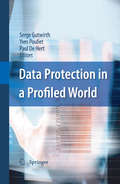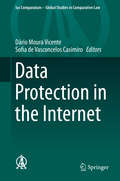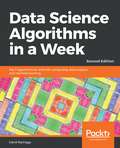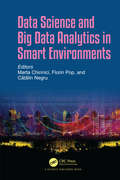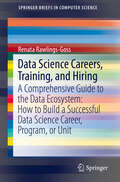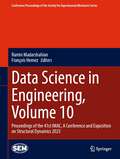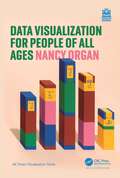- Table View
- List View
Data Protection in a Profiled World
by Serge Gutwirth Yves Poullet Paul De HertOne of the most challenging issues facing our current information society is the accelerating accumulation of data trails in transactional and communication systems, which may be used not only to profile the behaviour of individuals for commercial, marketing and law enforcement purposes, but also to locate and follow things and actions. Data mining, convergence, interoperability, ever- increasing computer capacities and the extreme miniaturisation of the hardware are all elements which contribute to a major contemporary challenge: the profiled world. This interdisciplinary volume offers twenty contributions that delve deeper into some of the complex but urgent questions that this profiled world addresses to data protection and privacy. The chapters of this volume were all presented at the second Conference on Privacy and Data Protection (CPDP2009) held in Brussels in January 2009 (www.cpdpconferences.org). The yearly CPDP conferences aim to become Europe’s most important meeting where academics, practitioners, policy-makers and activists come together to exchange ideas and discuss emerging issues in information technology, privacy and data protection and law. This volume reflects the richness of the conference, containing chapters by leading lawyers, policymakers, computer, technology assessment and social scientists. The chapters cover generic themes such as the evolution of a new generation of data protection laws and the constitutionalisation of data protection and more specific issues like security breaches, unsolicited adjustments, social networks, surveillance and electronic voting. This book not only offers a very close and timely look on the state of data protection and privacy in our profiled world, but it also explores and invents ways to make sure this world remains a world we want to live in.
Data Protection in the Internet (Ius Comparatum - Global Studies in Comparative Law #38)
by Dário Moura Vicente Sofia de Vasconcelos CasimiroThis book identifies and explains the different national approaches to data protection – the legal regulation of the collection, storage, transmission and use of information concerning identified or identifiable individuals – and determines the extent to which they could be harmonised in the foreseeable future. In recent years, data protection has become a major concern in many countries, as well as at supranational and international levels. In fact, the emergence of computing technologies that allow lower-cost processing of increasing amounts of information, associated with the advent and exponential use of the Internet and other communication networks and the widespread liberalization of the trans-border flow of information have enabled the large-scale collection and processing of personal data, not only for scientific or commercial uses, but also for political uses. A growing number of governmental and private organizations now possess and use data processing in order to determine, predict and influence individual behavior in all fields of human activity. This inevitably entails new risks, from the perspective of individual privacy, but also other fundamental rights, such as the right not to be discriminated against, fair competition between commercial enterprises and the proper functioning of democratic institutions. These phenomena have not been ignored from a legal point of view: at the national, supranational and international levels, an increasing number of regulatory instruments – including the European Union’s General Data Protection Regulation applicable as of 25 May 2018 – have been adopted with the purpose of preventing personal data misuse. Nevertheless, distinct national approaches still prevail in this domain, notably those that separate the comprehensive and detailed protective rules adopted in Europe since the 1995 Directive on the processing of personal data from the more fragmented and liberal attitude of American courts and legislators in this respect. In a globalized world, in which personal data can instantly circulate and be used simultaneously in communications networks that are ubiquitous by nature, these different national and regional approaches are a major source of legal conflict.
Data Quality in the Age of AI: Build A Foundation For Your Ai Strategy And Data Culture
by Andrew JonesBuilding a foundation for AI strategy and data culture
Data Science Algorithms in a Week, Second Edition: Top 7 Algorithms For Scientific Computing, Data Analysis, And Machine Learning, 2nd Edition
by Dávid NatinggaChoosing the right algorithm is often a key differentiator in the success or failure of a data model and its optimal performance. This book introduces you to 7 key machine learning algorithms which you can easily grasp within a week and includes exercises that will help you learn different aspects of machine learning without any hassle.
Data Science and Big Data Analytics in Smart Environments
by Marta Chinnici Florin Pop Catalin NegruMost applications generate large datasets, like social networking and social influence programs, smart cities applications, smart house environments, Cloud applications, public web sites, scientific experiments and simulations, data warehouse, monitoring platforms, and e-government services. Data grows rapidly, since applications produce continuously increasing volumes of both unstructured and structured data. Large-scale interconnected systems aim to aggregate and efficiently exploit the power of widely distributed resources. In this context, major solutions for scalability, mobility, reliability, fault tolerance and security are required to achieve high performance and to create a smart environment. The impact on data processing, transfer and storage is the need to re-evaluate the approaches and solutions to better answer the user needs. A variety of solutions for specific applications and platforms exist so a thorough and systematic analysis of existing solutions for data science, data analytics, methods and algorithms used in Big Data processing and storage environments is significant in designing and implementing a smart environment.Fundamental issues pertaining to smart environments (smart cities, ambient assisted leaving, smart houses, green houses, cyber physical systems, etc.) are reviewed. Most of the current efforts still do not adequately address the heterogeneity of different distributed systems, the interoperability between them, and the systems resilience. This book will primarily encompass practical approaches that promote research in all aspects of data processing, data analytics, data processing in different type of systems: Cluster Computing, Grid Computing, Peer-to-Peer, Cloud/Edge/Fog Computing, all involving elements of heterogeneity, having a large variety of tools and software to manage them. The main role of resource management techniques in this domain is to create the suitable frameworks for development of applications and deployment in smart environments, with respect to high performance. The book focuses on topics covering algorithms, architectures, management models, high performance computing techniques and large-scale distributed systems.
Data Science and Big Data Analytics in Smart Environments
by Marta Chinnici; Florin Pop; Cătălin NegruMost applications generate large datasets, like social networking and social influence programs, smart cities applications, smart house environments, Cloud applications, public web sites, scientific experiments and simulations, data warehouse, monitoring platforms, and e-government services. Data grows rapidly, since applications produce continuously increasing volumes of both unstructured and structured data. Large-scale interconnected systems aim to aggregate and efficiently exploit the power of widely distributed resources. In this context, major solutions for scalability, mobility, reliability, fault tolerance and security are required to achieve high performance and to create a smart environment. The impact on data processing, transfer and storage is the need to re-evaluate the approaches and solutions to better answer the user needs. A variety of solutions for specific applications and platforms exist so a thorough and systematic analysis of existing solutions for data science, data analytics, methods and algorithms used in Big Data processing and storage environments is significant in designing and implementing a smart environment.Fundamental issues pertaining to smart environments (smart cities, ambient assisted leaving, smart houses, green houses, cyber physical systems, etc.) are reviewed. Most of the current efforts still do not adequately address the heterogeneity of different distributed systems, the interoperability between them, and the systems resilience. This book will primarily encompass practical approaches that promote research in all aspects of data processing, data analytics, data processing in different type of systems: Cluster Computing, Grid Computing, Peer-to-Peer, Cloud/Edge/Fog Computing, all involving elements of heterogeneity, having a large variety of tools and software to manage them. The main role of resource management techniques in this domain is to create the suitable frameworks for development of applications and deployment in smart environments, with respect to high performance. The book focuses on topics covering algorithms, architectures, management models, high performance computing techniques and large-scale distributed systems.
Data Science and SDGs: Challenges, Opportunities and Realities
by Bikas Kumar Sinha Md. Nurul Haque MollahThe book presents contributions on statistical models and methods applied, for both data science and SDGs, in one place. Measuring and controlling data of SDGs, data driven measurement of progress needs to be distributed to stakeholders. In this situation, the techniques used in data science, specially, in the big data analytics, play an important role rather than the traditional data gathering and manipulation techniques. This book fills this space through its twenty contributions. The contributions have been selected from those presented during the 7th International Conference on Data Science and Sustainable Development Goals organized by the Department of Statistics, University of Rajshahi, Bangladesh; and cover topics mainly on SDGs, bioinformatics, public health, medical informatics, environmental statistics, data science and machine learning. The contents of the volume would be useful to policymakers, researchers, government entities, civil society, and nonprofit organizations for monitoring and accelerating the progress of SDGs.
Data Science Careers, Training, and Hiring: A Comprehensive Guide to the Data Ecosystem: How to Build a Successful Data Science Career, Program, or Unit (SpringerBriefs in Computer Science)
by Renata Rawlings-GossThis book is an information packed overview of how to structure a data science career, a data science degree program, and how to hire a data science team, including resources and insights from the authors experience with national and international large-scale data projects as well as industry, academic and government partnerships, education, and workforce. Outlined here are tips and insights into navigating the data ecosystem as it currently stands, including career skills, current training programs, as well as practical hiring help and resources. Also, threaded through the book is the outline of a data ecosystem, as it could ultimately emerge, and how career seekers, training programs, and hiring managers can steer their careers, degree programs, and organizations to align with the broader future of data science. Instead of riding the current wave, the author ultimately seeks to help professionals, programs, and organizations alike prepare a sustainable plan for growth in this ever-changing world of data. The book is divided into three sections, the first “Building Data Careers”, is from the perspective of a potential career seeker interested in a career in data, the second “Building Data Programs” is from the perspective of a newly forming data science degree or training program, and the third “Building Data Talent and Workforce” is from the perspective of a Data and Analytics Hiring Manager. Each is a detailed introduction to the topic with practical steps and professional recommendations. The reason for presenting the book from different points of view is that, in the fast-paced data landscape, it is helpful to each group to more thoroughly understand the desires and challenges of the other. It will, for example, help the career seekers to understand best practices for hiring managers to better position themselves for jobs. It will be invaluable for data training programs to gain the perspective of career seekers, who they want to help and attract as students. Also, hiring managers will not only need data talent to hire, but workforce pipelines that can only come from partnerships with universities, data training programs, and educational experts. The interplay gives a broader perspective from which to build.
Data Science for Engineers
by Raghunathan Rengaswamy Resmi SureshWith tremendous improvement in computational power and availability of rich data, almost all engineering disciplines use data science at some level. This textbook presents material on data science comprehensively, and in a structured manner. It provides conceptual understanding of the fields of data science, machine learning, and artificial intelligence, with enough level of mathematical details necessary for the readers. This will help readers understand major thematic ideas in data science, machine learning and artificial intelligence, and implement first-level data science solutions to practical engineering problems. The book- Provides a systematic approach for understanding data science techniques Explain why machine learning techniques are able to cross-cut several disciplines. Covers topics including statistics, linear algebra and optimization from a data science perspective. Provides multiple examples to explain the underlying ideas in machine learning algorithms Describes several contemporary machine learning algorithms The textbook is primarily written for undergraduate and senior undergraduate students in different engineering disciplines including chemical engineering, mechanical engineering, electrical engineering, electronics and communications engineering for courses on data science, machine learning and artificial intelligence.
Data Science for Engineers
by Raghunathan Rengaswamy Resmi SureshWith tremendous improvement in computational power and availability of rich data, almost all engineering disciplines use data science at some level. This textbook presents material on data science comprehensively, and in a structured manner. It provides conceptual understanding of the fields of data science, machine learning, and artificial intelligence, with enough level of mathematical details necessary for the readers. This will help readers understand major thematic ideas in data science, machine learning and artificial intelligence, and implement first-level data science solutions to practical engineering problems. The book- Provides a systematic approach for understanding data science techniques Explain why machine learning techniques are able to cross-cut several disciplines. Covers topics including statistics, linear algebra and optimization from a data science perspective. Provides multiple examples to explain the underlying ideas in machine learning algorithms Describes several contemporary machine learning algorithms The textbook is primarily written for undergraduate and senior undergraduate students in different engineering disciplines including chemical engineering, mechanical engineering, electrical engineering, electronics and communications engineering for courses on data science, machine learning and artificial intelligence.
Data Science for Nano Image Analysis (International Series in Operations Research & Management Science #308)
by Chiwoo Park Yu DingThis book combines two distinctive topics: data science/image analysis and materials science. The purpose of this book is to show what type of nano material problems can be better solved by which set of data science methods. The majority of material science research is thus far carried out by domain-specific experts in material engineering, chemistry/chemical engineering, and mechanical & aerospace engineering. The book could benefit materials scientists and manufacturing engineers who were not exposed to systematic data science training while in schools, or data scientists in computer science or statistics disciplines who want to work on material image problems or contribute to materials discovery and optimization.This book provides in-depth discussions of how data science and operations research methods can help and improve nano image analysis, automating the otherwise manual and time-consuming operations for material engineering and enhancing decision making for nano material exploration. A broad set of data science methods are covered, including the representations of images, shape analysis, image pattern analysis, and analysis of streaming images, change points detection, graphical methods, and real-time dynamic modeling and object tracking. The data science methods are described in the context of nano image applications, with specific material science case studies.
Data Science for Neuroimaging: An Introduction
by Ariel Rokem Tal YarkoniData science methods and tools—including programming, data management, visualization, and machine learning—and their application to neuroimaging researchAs neuroimaging turns toward data-intensive discovery, researchers in the field must learn to access, manage, and analyze datasets at unprecedented scales. Concerns about reproducibility and increased rigor in reporting of scientific results also demand higher standards of computational practice. This book offers neuroimaging researchers an introduction to data science, presenting methods, tools, and approaches that facilitate automated, reproducible, and scalable analysis and understanding of data. Through guided, hands-on explorations of openly available neuroimaging datasets, the book explains such elements of data science as programming, data management, visualization, and machine learning, and describes their application to neuroimaging. Readers will come away with broadly relevant data science skills that they can easily translate to their own questions.• Fills the need for an authoritative resource on data science for neuroimaging researchers• Strong emphasis on programming• Provides extensive code examples written in the Python programming language• Draws on openly available neuroimaging datasets for examples• Written entirely in the Jupyter notebook format, so the code examples can be executed, modified, and re-executed as part of the learning process
Data Science for Social Good: Philanthropy and Social Impact in a Complex World (SpringerBriefs in Complexity)
by Massimo Lapucci Ciro CattutoThis book is a collection of reflections by thought leaders at first-mover organizations in the exploding field of "Data Science for Social Good", meant as the application of knowledge from computer science, complex systems and computational social science to challenges such as humanitarian response, public health, sustainable development. The book provides both an overview of scientific approaches to social impact – identifying a social need, targeting an intervention, measuring impact – and the complementary perspective of funders and philanthropies that are pushing forward this new sector. This book will appeal to students and researchers in the rapidly growing field of data science for social impact, to data scientists at companies whose data could be used to generate more public value, and to decision makers at nonprofits, foundations, and agencies that are designing their own agenda around data.
Data Science in Engineering, Volume 10: Proceedings of the 41st IMAC, A Conference and Exposition on Structural Dynamics 2023 (Conference Proceedings of the Society for Experimental Mechanics Series)
by Ramin Madarshahian François HemezData Science in Engineering, Volume 10: Proceedings of the 41st IMAC, A Conference and Exposition on Structural Dynamics, 2023, the tenth volume of ten from the Conference brings together contributions to this important area of research and engineering. The collection presents early findings and case studies on fundamental and applied aspects of Data Science in Engineering, including papers on:Novel Data-driven Analysis MethodsDeep Learning Gaussian Process AnalysisReal-time Video-based AnalysisApplications to Nonlinear Dynamics and Damage DetectionHigh-rate Structural Monitoring and Prognostics
Data Science, Learning by Latent Structures, and Knowledge Discovery (Studies in Classification, Data Analysis, and Knowledge Organization)
by Berthold Lausen Sabine Krolak-Schwerdt Matthias BöhmerThis volume comprises papers dedicated to data science and the extraction of knowledge from many types of data: structural, quantitative, or statistical approaches for the analysis of data; advances in classification, clustering and pattern recognition methods; strategies for modeling complex data and mining large data sets; applications of advanced methods in specific domains of practice. The contributions offer interesting applications to various disciplines such as psychology, biology, medical and health sciences; economics, marketing, banking and finance; engineering; geography and geology; archeology, sociology, educational sciences, linguistics and musicology; library science. The book contains the selected and peer-reviewed papers presented during the European Conference on Data Analysis (ECDA 2013) which was jointly held by the German Classification Society (GfKl) and the French-speaking Classification Society (SFC) in July 2013 at the University of Luxembourg.
Data Science with Python: Combine Python With Machine Learning Principles To Discover Hidden Patterns In Raw Data
by Rohan Chopra Aaron England Mohamed Noordeen AlaudeenCombine Python with machine learning principles to discover hidden patterns in raw data
Data Science with R for Psychologists and Healthcare Professionals
by Christian RyanThis introduction to R for students of psychology and health sciences aims to fast-track the reader through some of the most difficult aspects of learning to do data analysis and statistics. It demonstrates the benefits for reproducibility and reliability of using a programming language over commercial software packages such as SPSS. The early chapters build at a gentle pace, to give the reader confidence in moving from a point-and-click software environment, to the more robust and reliable world of statistical coding. This is a thoroughly modern and up-to-date approach using RStudio and the tidyverse. A range of R packages relevant to psychological research are discussed in detail. A great deal of research in the health sciences concerns questionnaire data, which may require recoding, aggregation and transformation before quantitative techniques and statistical analysis can be applied. R offers many useful and transparent functions to process data and check psychometric properties. These are illustrated in detail, along with a wide range of tools R affords for data visualisation. Many introductory statistics books for the health sciences rely on toy examples - in contrast, this book benefits from utilising open datasets from published psychological studies, to both motivate and demonstrate the transition from data manipulation and analysis to published report. R Markdown is becoming the preferred method for communicating in the open science community. This book also covers the detail of how to integrate the use of R Markdown documents into the research workflow and how to use these in preparing manuscripts for publication, adhering to the latest APA style guidelines.
Data Science with R for Psychologists and Healthcare Professionals
by Christian RyanThis introduction to R for students of psychology and health sciences aims to fast-track the reader through some of the most difficult aspects of learning to do data analysis and statistics. It demonstrates the benefits for reproducibility and reliability of using a programming language over commercial software packages such as SPSS. The early chapters build at a gentle pace, to give the reader confidence in moving from a point-and-click software environment, to the more robust and reliable world of statistical coding. This is a thoroughly modern and up-to-date approach using RStudio and the tidyverse. A range of R packages relevant to psychological research are discussed in detail. A great deal of research in the health sciences concerns questionnaire data, which may require recoding, aggregation and transformation before quantitative techniques and statistical analysis can be applied. R offers many useful and transparent functions to process data and check psychometric properties. These are illustrated in detail, along with a wide range of tools R affords for data visualisation. Many introductory statistics books for the health sciences rely on toy examples - in contrast, this book benefits from utilising open datasets from published psychological studies, to both motivate and demonstrate the transition from data manipulation and analysis to published report. R Markdown is becoming the preferred method for communicating in the open science community. This book also covers the detail of how to integrate the use of R Markdown documents into the research workflow and how to use these in preparing manuscripts for publication, adhering to the latest APA style guidelines.
Data Stewardship for Open Science: Implementing FAIR Principles
by Barend MonsData Stewardship for Open Science: Implementing FAIR Principles has been written with the intention of making scientists, funders, and innovators in all disciplines and stages of their professional activities broadly aware of the need, complexity, and challenges associated with open science, modern science communication, and data stewardship. The FAIR principles are used as a guide throughout the text, and this book should leave experimentalists consciously incompetent about data stewardship and motivated to respect data stewards as representatives of a new profession, while possibly motivating others to consider a career in the field. The ebook, avalable for no additional cost when you buy the paperback, will be updated every 6 months on average (providing that significant updates are needed or avaialble). Readers will have the opportunity to contribute material towards these updates, and to develop their own data management plans, via the free Data Stewardship Wizard.
Data Stewardship for Open Science: Implementing FAIR Principles
by Barend MonsData Stewardship for Open Science: Implementing FAIR Principles has been written with the intention of making scientists, funders, and innovators in all disciplines and stages of their professional activities broadly aware of the need, complexity, and challenges associated with open science, modern science communication, and data stewardship. The FAIR principles are used as a guide throughout the text, and this book should leave experimentalists consciously incompetent about data stewardship and motivated to respect data stewards as representatives of a new profession, while possibly motivating others to consider a career in the field. The ebook, avalable for no additional cost when you buy the paperback, will be updated every 6 months on average (providing that significant updates are needed or avaialble). Readers will have the opportunity to contribute material towards these updates, and to develop their own data management plans, via the free Data Stewardship Wizard.
Data Visualization for People of All Ages (ISSN)
by Nancy OrganData visualization is the art and science of making information visible. On paper and in our imaginations, it’s a language of shapes and colors that holds our best ideas and most important questions. As we find ourselves swimming in data of all kinds, visualization can help us to understand, express, and explore the richness of the world around us. No matter your age or background, this book opens the door to new ways of thinking and sharing through the power of data visualization.Data Visualization for People of All Ages is a field guide to visual literacy, born from the author’s personal experience working with world-class scholars, engineers, and scientists. By walking through the different ways of showing data—including color, angle, position, and length—you’ll learn how charts and graphs truly work so that no visualization is ever a mystery or out of reach. It doesn’t stop at what fits on a page, either. You’ll journey into cutting-edge topics like data sonification and data physicalization, using sound and touch to share data across the different senses. Packed with practical examples and exercises to help you connect the dots, this book will teach you how to create and understand data visualizations on your own—all without writing a single line of code or getting tangled up in software.Written with accessibility in mind, this book invites everyone to the table to share the joy of one of today’s most necessary skills. Perfect for home or classroom use, this friendly companion gives people of all ages everything they need to start visualizing with confidence.
Data Visualization for People of All Ages (ISSN)
by Nancy OrganData visualization is the art and science of making information visible. On paper and in our imaginations, it’s a language of shapes and colors that holds our best ideas and most important questions. As we find ourselves swimming in data of all kinds, visualization can help us to understand, express, and explore the richness of the world around us. No matter your age or background, this book opens the door to new ways of thinking and sharing through the power of data visualization.Data Visualization for People of All Ages is a field guide to visual literacy, born from the author’s personal experience working with world-class scholars, engineers, and scientists. By walking through the different ways of showing data—including color, angle, position, and length—you’ll learn how charts and graphs truly work so that no visualization is ever a mystery or out of reach. It doesn’t stop at what fits on a page, either. You’ll journey into cutting-edge topics like data sonification and data physicalization, using sound and touch to share data across the different senses. Packed with practical examples and exercises to help you connect the dots, this book will teach you how to create and understand data visualizations on your own—all without writing a single line of code or getting tangled up in software.Written with accessibility in mind, this book invites everyone to the table to share the joy of one of today’s most necessary skills. Perfect for home or classroom use, this friendly companion gives people of all ages everything they need to start visualizing with confidence.
Data Warehousing for Biomedical Informatics
by Richard E. BiehlData Warehousing for Biomedical Informatics is a step-by-step how-to guide for designing and building an enterprise-wide data warehouse across a biomedical or healthcare institution, using a four-iteration lifecycle and standardized design pattern. It enables you to quickly implement a fully-scalable generic data architecture that supports your organization's clinical, operational, administrative, financial, and research data. By following the guidelines in this book, you will be able to successfully progress through the Alpha, Beta, and Gamma versions, plus fully implement your first production release in about a year.
Data Warehousing for Biomedical Informatics
by Richard E. BiehlData Warehousing for Biomedical Informatics is a step-by-step how-to guide for designing and building an enterprise-wide data warehouse across a biomedical or healthcare institution, using a four-iteration lifecycle and standardized design pattern. It enables you to quickly implement a fully-scalable generic data architecture that supports your organization's clinical, operational, administrative, financial, and research data. By following the guidelines in this book, you will be able to successfully progress through the Alpha, Beta, and Gamma versions, plus fully implement your first production release in about a year.
Database and Expert Systems Applications: DEXA 2018 International Workshops, BDMICS, BIOKDD, and TIR, Regensburg, Germany, September 3–6, 2018, Proceedings (Communications in Computer and Information Science #903)
by Mourad Elloumi Michael Granitzer Abdelkader Hameurlain Christin Seifert Benno Stein A Min Tjoa Roland WagnerThis volume constitutes the refereed proceedings of the three workshops held at the 29th International Conference on Database and Expert Systems Applications, DEXA 2018, held in Regensburg, Germany, in September 2018: the Third International Workshop on Big Data Management in Cloud Systems, BDMICS 2018, the 9th International Workshop on Biological Knowledge Discovery from Data, BIOKDD, and the 15th International Workshop on Technologies for Information Retrieval, TIR.The 25 revised full papers were carefully reviewed and selected from 33 submissions. The papers discuss a range of topics including: parallel data management systems, consistency and privacy cloud computing and graph queries, web and domain corpora, NLP applications, social media and personalization
